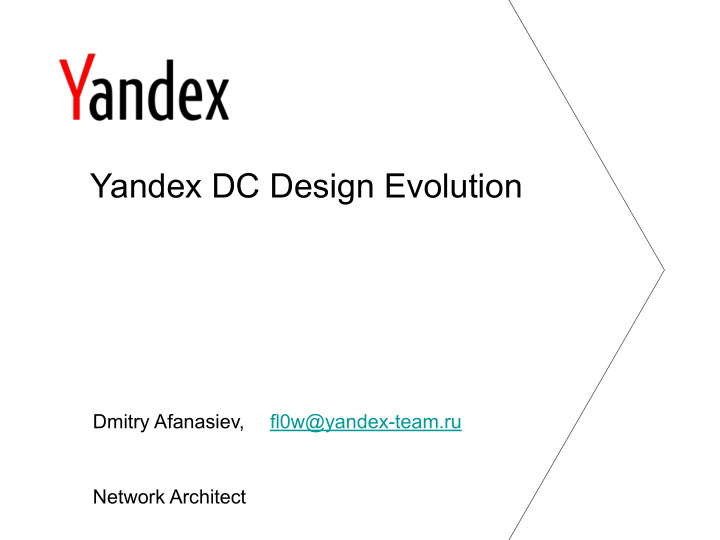



Yandex DC Design Evolution Dmitry Afanasiev, fl0w@yandex-team.ru Network Architect
Yandex • We're rather typical MSDC • Monthly user audience of over 90 million worldwide. • ~Services: search, music, video, cloud storage, news, weather, maps, traffic, email, ads ... • Several DCs in Russia and abroad + peering and traffic exchange points + MPLS backbone to connect them • Workloads: interactive request processing, object storage, map-reduce-like, data streaming, large scale replication, machine learning... 2
What we need? • Cheap and abundant bandwidth • Scalable forwarding with minimal state • Multitenancy / network virtualization - for historical reasons • Efficient resource pooling • InterDC traffic engineering • Stable routing system and reasonably fast convergence • Function chaining: load balancing, FW, etc. • Automation at scale 3
What we don’t need We are trying to keep design really simple. Don’t need many functions often perceived as desireable: • L2 (but nodes can use overlays) • VM mobility – In scale-out applications nodes coming and going is a norm, no need to move them around while preserving state and identity – VM mobility increases complexity as it depends on other features • Multicast • We don't have too many changes in topology 4
Our Infrastructure • About 100k servers and growing fast • Mostly IPv6 internally, need to serve external IPv4 - tunnels • 2 WANs - for interactive and bulk traffic • 10GE to the server, Nx100GE inter-switch in DC, Nx100GE WAN, looking at 25GE to the server • Eliminated L2 in new DC designs -> L3 to the ToR (VPN or multi-VRF), smaller L3 domains in some locations (L3/port and eventually to server) • Eliminated multi-hop multicast • /64 per server (for virtualization, also removes most ND from ToRs) • Still need FW (technical debt), moving to hosts (HBF), some tricks with host part of IPv6 addr 5
Our Infrastructure (2) • Need to support 10k+ nodes clusters, recent DC design scales to 25-30k nodes • Clos fabrics, 2 spine layers • modular spines but also looking at fixed boxes (need radix >= 64 to stay with 2 spine layers) • 1k-4k ECMP routes per DC, 4x-16x ECMP, can be 32x in future • one of the limits is power • another is ECMP table(s) size with MPLS on ToRs - need separate rewrite entries for each next hop, can be improved with global labels 6
Our Infrastructure (3) • BGP in DC fabrics - 2 flavors • iBGP and per-hop RR+NHS, similar to RFC 7938 • iBGP with off-path route servers (some modular routers don't work well with 100s of BGP sessions) • OSPF + TE in WANs, considering SR-TE in future • DC borders are starting to look like small fabrics 7
Challenges and Future Work • Diagnostics, measurements and monitoring - need to look at fast processes and transient events - buffering, convergence • Balance between reducing control traffic and aggregating routing information and disseminating enough information to achieve • granular enough traffic manipulation - drain, steering, TE between DCs • adjusting load balancing in presence of failures - need to look beyond 1 hop even in highly regular topologies • Combining programmability/centralized control with local reaction to failures • BGP is really useful here - a lot can be done with controller that looks just like RR from protocol PoV but implements more complex logic 8
Questions?
Recommend
More recommend